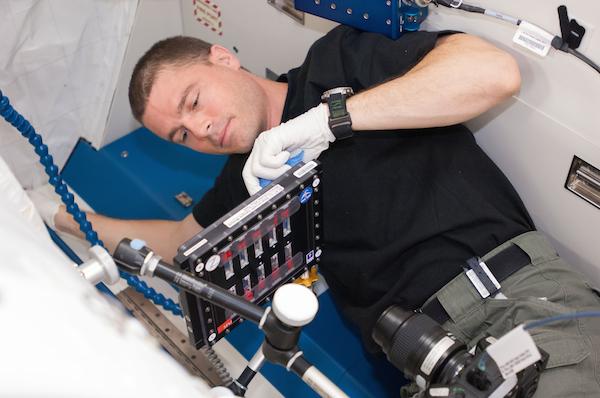
[Image above] NASA astronaut Reid Wiseman conducts a session with the Binary Colloidal Alloy Test-C1 experiment during his mission on the International Space Station in 2014. Credit: NASA
There’s a new place for materials, and it’s out of this world.
No metaphors or hyperbole—NASA and NIST recently joined forces to establish MaterialsLab, a new data-ridden initiative aimed to accelerate “materials development and make new discoveries using data from the hundreds of investigations on the International Space Station,” according to a NASA news release.
The initiative’s goal, in collaboration with the Materials Genome Initiative, is to open access to materials research that happens in space to government, academia, and industry researchers who are investigating and characterizing new materials.
Because ISS experiments provide a wealth of data about physical and chemical properties of materials, the initiative is a strategy to make the most of each experiment’s data.
“We’re creating a new opportunity to develop materials experiments in space that makes it easier for scientists to conduct these investigations and share their research and data widely with the scientific community,” Marshall Porterfield, NASA’s director of Space Life and Physical Sciences, says in the release. “The Open Science concept allows multiple researchers around the world the ability to access data from station experiments and build on each other’s work.”

Dendrite formations, shown here, affect the process of metals casting. Results from this International Space Station investigation are an example of materials science data that would be included in the MaterialsLab database. Credits: Peter Voorhees; Northwestern University
The collaboration expands applications of microgravity materials research beyond space-only purposes to applications here on land, too.
“We want to conduct new investigations that fulfill a specific industry need or could lead to a new commercial application,” John Vickers, manager of NASA’s National Center for Advanced Manufacturing, says in the release. “If the automobile industry is having a problem with a specific material, we may be able to study that material on the station and get an answer that they couldn’t obtain through ground-based research. We are not only learning about the material, but also providing valuable data that immediately affects companies and consumers on Earth.”
Data from far space will be shared through NASA’s Physical Science Informatics (PSI) system, a public repository for ISS experimental data.
Check out all the experimental data already in the PSI system—including studies of pore formation and mobility, coarsening in solid–liquid mixtures, and in-space soldering—right here.
NASA is expected to soon solicit research proposals “to generate new scientific insights by utilizing experimental data residing in NASA’s PSI system,” specifically in theme areas of combustion science, complex fluids, fluid physics, fundamental physics, and—our favorite—materials science.
So start prepping those proposals. And when the research is done, there’s a perfect place to publish—npj Microgravity (from Nature Publishing Group), a new open-access journal all about life science, physical science, and engineering research done sans gravity.
Author
April Gocha
CTT Categories
- Aeronautics & Space
- Basic Science
- Material Innovations


